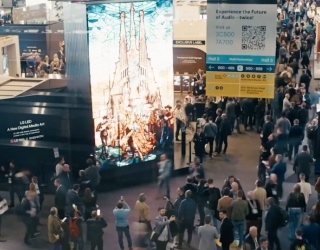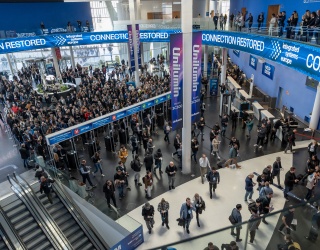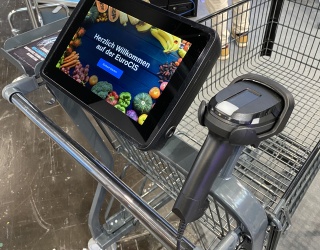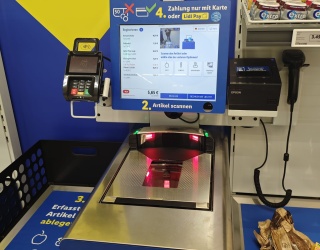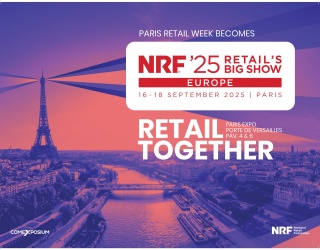
In April of 2003 the Metro Group – at that time located at the Extra Future Store in Rheinberg, Germany – started to introduce self-checkout registers in German food retailing. In October 2003 the rollout began in Ratingen near Düsseldorf. According to Uwe Pieper, at this point nationwide approximately 70 real,- hypermarkets are furnished with self-checkout counters. Yet sometimes equipment is also being taken down again. In this EuroCIS interview he talks about customers, configurations and cash register employees.
Which configuration has proven to be the best?
We primarily use the so-called "scan 'n bag" scanning solution. This means: a group of four self-checkout registers, with two self-checkout registers in each of two lanes, one behind the other and two self-checkout registers each across from each other on both sides. With this system the customer pushes his cart directly to the self-checkout lane, scans his article and then immediately places it into a shopping bag. There is no need for a conveyor belt at the checkout counter.
How many self-checkout registers would you still like to set up?
The use of self-checkout counters involves a larger investment from every company. That’s precisely why we generally check each individual market to see whether we are indeed meeting the wishes of our customers for an even higher customer orientation by using self-checkout counters. Besides, the use of self-checkout lanes is not an issue in new buildings, whereas in already existing areas, structural requirements might argue against their use.
What space requirements do you calculate for self-checkout counters compared to staffed checkout counters?
By installing four self-checkout lanes, the number of previously used checkout counters is usually only reduced by one counter and in some locations at most by two conventional checkout registers. So the number of available checkouts for the customer is definitely increasing at any rate and for our customers it means further relief from the entire checkout activity during peak hours. On average a real,- hypermarket has more than 15 conventional checkout counters.
Speaking of staff: How many fewer employees do you now have in the checkout lanes? Have there been layoffs because of it?
There have been no cutbacks in checkout personnel due to the additional use of self-checkout counters in any of the mentioned locations.
How long is the introductory phase in the hypermarkets and what should you watch out for?
The introductory phase for self-checkout counters takes about seven days. This includes the set-up and to start running the systems as well as training of the associates. Needless to say you have to make sure that the technology is perfectly connected and the system is seamlessly fed with data. The employees also have to familiarize themselves with the new system and understand the technology. This is the only way we can optimally serve our customers and make sure to quickly and competently assist them if there are any problems.
Which group of customers uses these checkouts in particular?
In all of the studies we or the manufacturer conducted on this subject so far, one thing has become clear: there are now clearly fans of self-checkout counters.
These are customers who – whenever possible – utilize the self-checkout lanes as a time-saving payment alternative. This includes especially customers with a small shopping cart, who appreciate the advantages of the self-checkout lane. Examples for this are office employees working near our markets, who purchase three to four items for their lunch and by using the self-checkout have the chance to quickly leave our store again and still have enough time for their lunch hour left.
Another group for instance are mechanics who buy a few groceries for the day in the mornings on their way to the customer. These groups of customers are glad if they – thanks to the self-checkout lane- can quickly finish their shopping.
Yet there are also customers who thus far refuse to use the self-checkout counters. There are many different reasons for this. Some customers simply don’t want to change and adjust and are not fundamentally against the self-checkout counter, but don’t want to handle the checkout on their own. And they actually don’t have to do this on their own when they shop with us, because at each location we continue to offer the “normal checkout counter“. And there are customers who categorically object to the use of self-checkout counters. And for this customer group we also offer the chance to pay for their items at the well-known checkout registers. There are still associates available to have a little chat with you at the checkout counter.
Among both of these customer groups there are the pragmatics, who always use the self-checkout counter if it would take them far too long at the regular checkout during peak hours. But our research also shows that many customers still choose the conventional checkout counter if they make a lot of purchases, since our well-trained and skilled staff simply scans the many items and completes the checkout process faster than our customers would be able to do.
What self-checkout user rate is satisfactory for you?
When it comes to the use of self-checkout system it is not about a quota, but the fact that our customers don’t have to wait a long time in the checkout area. We ensure this by using the always open self-checkout counters as a “fast lane“ and thus an alternative to conventional checkout counters.
How many of your stores reach this quota?
We noticed in all branches where we have self-checkout lanes that things are clearly more relaxed during checkout times.
Example Hemmingen, Germany: You have a former Wal-Mart store there. In 2011, self-checkout counters were introduced there – and some have already been taken away again. Why? Is that a typical scenario?
What’s typical in this case is that new approaches are being tested with these kinds of projects. If it turns out during the course of the project that they are not being accepted by the customers as was initially expected, naturally the new system is modified and adapted to customer needs.
Cash or credit – is the payment behavior at self-checkout counters different from that exhibited at the service counters? Are cashless payments going to increase with wireless money?
At the self-checkout registers, purchases can be paid for with cash, EC-card (Eurocheque debit card) or credit card. Payment behavior does not differ greatly from payment behavior at the conventional checkout counters. Whether paying with NFC is becoming accepted is not something we can say at this point in time. Starting the end of January 2012, the real,- Future Store in Tönisvorst offers the option of paying with NFC as an additional payment method.
Some customers like to use the payment machines to get rid of the change in their wallets. Can you quantify a cost-saving effect for cash recycling?
So far we couldn’t observe that customers only use the payment machines to get rid of their spare change. And so we consequently don’t see this as an issue either.
How high is the fraud rate at self-checkout counters?
We are not seeing a particularly large number of thefts at our self-checkout counters, since we integrated an anti-theft protection device in the system. There is a scale underneath the bag which compares the weight of the item placed in the bag with the specific product weight stored in a database for this article. If the difference is too big, the checkout locks up and has to manually be released again.
By comparison, how big are teller differences at staffed checkout counters?
Please understand that we are not able to give any particulars on this issue.
How fast or slow are customers during scanning?
This shows another advantage of self-checkout counters: it’s the customer himself that determines the speed and he can bag his purchased items whichever way he wants.
What do you expect from the EuroCIS in terms of self-checkout counters and self-checkout terminals?
Each year exciting new technologies and trends for the retail market are being introduced there. This year we also expect many further developments and like to be persuaded by the progress.
Interview by René Schellbach, First publication EuroCIS.com
23/02/2012




